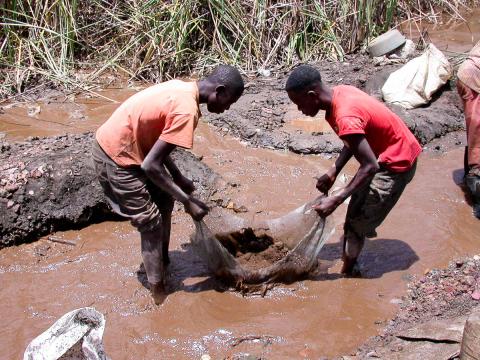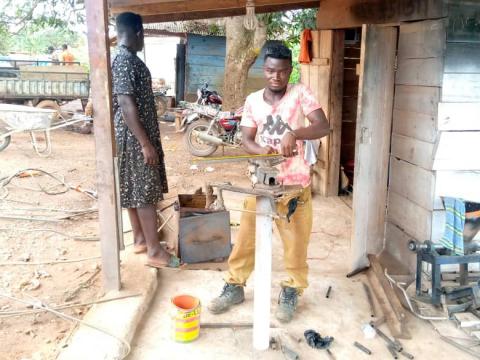
My family’s generations of mineworkers have shown me the perils of child labour
To save children from this fate is personal for Mirela. She presents World Vision's unique research into identifying barriers and enablers of child labour, and explains how we can use social and behaviour change interventions to end these practices worldwide.
I was born in rural Romania, close to a 2000-year-old gold mine. For more than twenty centuries, the fate of my village had been linked to that of this precious metal. In the beginning, ‘our’ gold mine contributed to the opulence of the Roman Empire, while closer to our days, it funded the adventures of the Austro-Hungarian Empire.
My father was a miner for a few years, but he could hardly wait to find a different job: he was young and strong, but mining was too hard, dirty and soul-wrecking. His father had been a miner, and his father’s father too, just like his great grandfather’s father and so on, back to the times of Jesus. The family legend says that one of my great-great-great fathers had travelled to the US to participate in the California Gold Rush. Apparently, he came back so rich that he never had to work again. He was the family and village hero: a man who never had to descend into a mine pit again.
I have a special sensitivity for people working in mines – especially children. I vaguely remember the stories my grandfather would tell me about how hard it was for children to have to do mine related work. I can’t remember the specifics, but I do remember the emotion I felt and that still continues today. If my strong, nourished father ran away from that job, how is it possible that young and frequently malnourished children are sent to do such work?
Today, In the Democratic Republic of Congo (DRC) and in many other places around the world, children are encouraged, required or forced into some of the worst forms of labour, including street vending, begging and mining. To address this reality, Partnerships to End Child Exploitation (PACE)) was established that includes international NGOs, the private sector, a world-renowned university, a corporate foundation and a media development agency to tackle one of the world’s most pressing and complex development issues.
Operating in three countries (DRC, Ethiopia and the Central African Republic), the Partnership aims to answer a simple question: “How do we protect children from the worst forms of child labour?” In other words, what barriers and enablers keep children out of school and in the mining fields?
To understand that, World Vision DRC conducted a Barrier Analysis, a research method developed by my colleague and mentor Tom Davis in the 1990s. We asked the same questions to two parental groups: 45 parents who kept their children in school and out of the worst forms of labour (including minefields) and 45 parents who allowed, encouraged, required or forced their children out of school and into the worst forms of labour.
We called the first group “Doers” like in “Doers of the behaviour that we encourage: keeping children in school and out of the worst forms of labour,” and the second group “Non-Doers” like in “people who do not do the behaviour we promote, which is keeping children in school and out of the worst forms of labour.” What we discovered about the difference between Doers and Non-Doers (ND) gave us unique and surprising insights about possible social and behaviour change interventions that hold game-changing potential.
For example, in our sample, a common desire of all parents was that their children are happy, grow up well, have access to job opportunities and become useful adults for themselves and society as a whole. And still, many of the same parents did not hesitate to take their children out of school and encourage them to take some of the worst forms of paid labour. We discovered that these parents were 8.5 times more likely to believe that children who do not work at a young age will grow up to be lazy and poor, which will bring many sufferings upon them in their futures. Out of very good intentions – ensuring children’s long-term success – these parents were ruining the exact thing that was most precious to them. This discovery alone could have a major impact when translated into programming decisions. Still, the study generated a total of 26 significant and actionable findings.
We were not surprised to learn that some of the parents allow or encourage their children to work because they need a regular and additional source of income to support the family and cover the school fees. This is a very poor region, where half of the population has no formal education, and only 6% have a TV set. At the same time, Doer parents are 1.5 times more likely to say that they can refrain from sending children to work because they understand that children have a basic human right to education. Along similar lines, Doer parents are 1.8 times more likely to believe that their children are too young to engage in any kind of work, which also implies an elevated understanding of a child’s right to education and having a childhood.
In addition, we understood how important it is for parents to trust the educational systems and opportunities. Doer parents are 1.6 times more likely than ND parents to report that it is easy to refrain from sending their children to work because they believe education will afford their child a good job and future income stream. This long-term vision demonstrates their high value on education.
To us, the solution is simple. But sadly, we assume that we as researchers understand human psychology better than we do. We think that we should just tell parents how important it is for children to learn and play instead of working. But what do you tell parents who truly believe that your advice will spoil their children and ruin their future?
Formative research is essential for understanding why people behave the way they do and is fundamental if we design adequate interventions that will lead to real and sustainable changes in behaviours. In this case, we chose to conduct a Barrier Analysis study, but of course, there are many other options. The beauty of a Barrier Analysis is that data can be collected in just a few days and is relatively easy to analyse. Moreover, it provides statistically relevant information about the differences between the doers of specific behaviour and the non-doers; and it is therefore hugely useful for identifying the most significant differences between the attitudes, beliefs and practices of the behaviour which can then be used to create very targeted and effective interventions.
We need to invest more in this type of research and, in general, in social and behaviour change for ending violence against children (SBC4EVAC), as SBC interventions apply systematic insights about why people behave the way they do and how their behaviours change over time.
Harmful “traditions” can and should be changed. In my village 2000 years of mining history abruptly changed course and now it is simply unthinkable that a child could be sent to work at the mine site. I am among the last generation who personally know somebody who suffered in the mines as a child. Given my personal experience, I am convinced that child labour can be eradicated, if we: ensure funding for research and programmes; build capacities to address child labour; and understand and champion the critical role of social and behaviour change for ending violence against children, including by targeting parents, teachers and local businesses to help keep children in school.
Mirela Oprea is an experienced advocacy and social development professional, with a BA in psychology and educational sciences and a PhD in international development. Currently she serves as an Advisor for Social Norms and Behaviour Change for World Vision International, harnessing behaviour science for ending violence against children.
